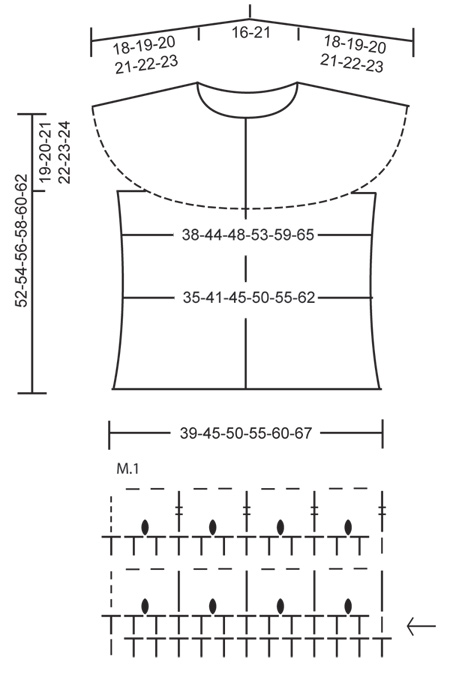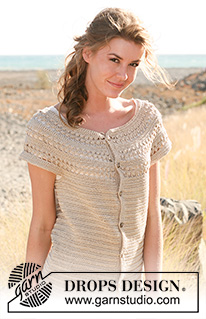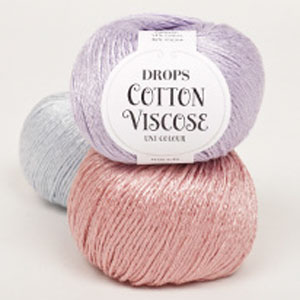Comments / Questions (42)
![]() MOUTHON wrote:
MOUTHON wrote:
Bonjour, Il n y a aucune explication pour les finitions des manches et tour du cou. Est ce votre choix ou un oubli? Merci
14.08.2022 - 11:31DROPS Design answered:
Bonjour Mme Mouthon, il n'y a aucune bordure supplémentaire à crocheter dans ce modèle, mais vous pouvez volontiers en faire une si vous le souhaitez. Bon crochet!
15.08.2022 - 08:27
![]() Gerda wrote:
Gerda wrote:
Na het 3de patroondeel M1 en de 4 toeren vasten staat er "ga verder en haak heen en weer met 1v in iedere vast en meerder in de 1ste toer 28-31-...... vasten" maar hoeveel toeren vasten moet men hier nog doen. slechts 1 of tot je het juiste aantal cm hebt?
08.03.2020 - 13:51DROPS Design answered:
Dag Gerda,
Op dat punt meerder je alleen in de eerste toer van vasten een aantal steken zoals aangegeven in het patroon. De volgende toeren daarna haak je dus 1 vaste in elke vaste tot een hoogte van 18-19-20-21-22-23 cm ((staat in eerste regel van de paragraaf daaronder).
10.03.2020 - 19:57
![]() Dorothy Harrington wrote:
Dorothy Harrington wrote:
Could I use Lima for this pattern?
29.01.2019 - 21:46DROPS Design answered:
Dear Mrs Harrington, DROPS Lima belongs to yarn group B our yarn while this top is worked with DROPS Cotton Viscose which was yarn group A - find alternatives by trying our yarn converter and read more about alternatives here. Happy crocheting!
30.01.2019 - 07:35
![]() Susan Starke wrote:
Susan Starke wrote:
Sehr schöne Jacke für laue Sommerabende.Einfach und schnell gehäkelt.
06.06.2016 - 21:05
![]() Willers wrote:
Willers wrote:
Thank you for the lovely pattern. I am having difficulty with the M1. Please translate in words. Thanks again.
12.05.2016 - 23:12DROPS Design answered:
Dear Mrs Willers, start reading diagram from the right towards the left from RS (1st row = with arrow), and from the left towards the right from WS. On 1st row, you will then work: 1 ch (= 1st sc), *1 sc in next st, 1 picot, 1 sc in next 2 sts*, repeat from *-*. On row 2, chain 3 (=1st dc), *ch2, skip 2 sc, 1 dc in next dc*, repeat from *-*. Happy crocheting!
13.05.2016 - 09:11
![]() Elizabeth wrote:
Elizabeth wrote:
Elizabeth 21.06.2015 kl. 21:15: Zou dit patroon ook met Drops Cotton Merino gehaakt kunnen worden? (Staat niet bij alternatieve garens).
22.06.2015 - 09:30DROPS Design answered:
Hoi Elizabeth. Nee, Cotton Merino is te dik voor dit model. Probeer eventueel een proeflapje te haken en zien welk naald je nodig hebt voor de juiste stekenverhouding (22 stk/v = 10 cm) en kijk of je de structuur mooi vindt (ik denk dat het te stug wordt).
23.06.2015 - 11:56
![]() Ingrid wrote:
Ingrid wrote:
Is het ook mogelijk om langere mouwen aan het vestje te maken? Zo ja, hoe kan ik dat het beste doen?
30.04.2014 - 12:09DROPS Design answered:
Wij ondersteunen vragen over de patronen zoals onze designafdeling ze heeft gemaakt, maar we helpen niet bij het maken van persoonlijke aanpassingen. Wellicht is er een haak- of breigroep bij u in de buurt met mensen die u hierbij willen helpen.
30.04.2014 - 21:37
![]() Schiller, Birgit wrote:
Schiller, Birgit wrote:
Ich habe eine Frage zu den Zunahmen. Es fängt bei mir schon nach dem M1 an. Danach habe ich bei Größe S 154 fM und soll nun 39 Maschen gleichmäßig verteilt aufnehmen. Was heißt denn hier gleichmäßig? Wenn ich 154/39 teile komme ich auf 3,94 Maschen... Wie soll ich jede 3,94 Masche zunehmen? Aufrunden auf 4 geht ja auch nicht, dann komme ich ja wieder mit dem Muster nicht hin. Auch weiter unten das selbe Problem.Wie sind denn da nun die Abstände?
22.09.2013 - 22:40DROPS Design answered:
Liebe Birgit, die Aufnahme ist in einer Reihe mit festen Maschen, daher beeinträchtigt es das Muster nicht. Sie häkeln nachher das Muster einfach über die grössere Maschenzahl. Natürlich können Sie nur nach ganzen Maschen aufnehmen, achten Sie einfach darauf, dass es (schön verteilt) insgesamt 39 M sind.
23.09.2013 - 08:18
![]() Erie wrote:
Erie wrote:
Dank u wel voor uw antwoord. Helaas is me nog niet duidelijk wat ik dan verkeerd doe. Stekenaantal is precies zoals beschreven. Misschien gelijk na de pas al gaan minderen?
10.06.2013 - 13:13DROPS Design answered:
Met de juiste stekenverhouding (22 stk/v) per 10 cm zou je op de juiste afmetingen komen. Controleer of de stekenverhouding klopt.
11.06.2013 - 15:16
![]() Erie wrote:
Erie wrote:
Prachtig patroon, maar ik heb een vraag. De pas heb ik klaar, afmeting klopt. Nu heb ik zo'n 10 cm van de panden gedaan, maar het werk is inmiddels al 7 cm breder geworden en ik ben nog lang niet aan het minderen toe. Ik heb uiteraard niet gemeerderd ;) Wat doe ik verkeerd?
09.06.2013 - 16:01DROPS Design answered:
Het werk moet niet breder worden. Het aantal stk moet gelijk blijven tot je gaat minderen zoals beschreven.
10.06.2013 - 12:43
Hayfield Beauty#hayfieldbeautycardigan |
|||||||||||||||||||
 |
 |
||||||||||||||||||
Crochet DROPS short sleeved jacket with lace pattern and round yoke in ”Cotton Viscose”. The piece is worked top down. Size: S - XXXL.
DROPS 130-10 |
|||||||||||||||||||
|
CROCHET INFO: Replace first sc on every sc row with ch 1 and finish every sc row with 1 sc in ch from beg of previous row. Replace first dc on every dc row with ch 3 and finish every dc row with 1 dc in 3rd ch from beg of previous row. INCREASE TIP: Inc 1 sc by working 2 sc in 1 sc. Inc 1 dc by working 2 dc in 1 dc. DECREASE TIP: Dec 1 dc by working 1 dc but wait with last pull through (= 2 sts on hook), then work next dc but on last pull through, pull thread through all sts on hook = 1 dc dec. PATTERN: See explanation below or diagram M.1 - diagram shows pattern seen from RS. ROW 1: ch 1 (= 1 sc), 1 sc in next st, * ch 4, 1 sl st in 1st ch (1 picot), 1 sc in each of the next 3 sts *, repeat from *-* until 2 sts remain, finish with 1 picot and 1 sc in each of the last 2 sts, turn piece. ROW 2: ch 5 (= 1 dc + 2 ch), skip 1 sc + 1 picot + 1 sc, work 1 dc in next sc, * ch 2, skip 1 sc + 1 picot + 1 sc, work 1 dc in next sc *, repeat from *-* the rest of the row, turn piece. ROW 3: ch 1, * work 1 sc + 1 picot + 1 sc in ch space, 1 sc in next dc *, repeat from *-* the rest of the row. ROW 4: ch 6 (= 1 tr + 2 ch), skip 1 sc + 1 picot + 1 sc, work 1 tr in next sc, * ch 2, skip 1 sc + 1 picot + 1 sc, work 1 tr in next sc *, repeat from *-* the rest of the row. -------------------------------------------------------- JACKET: The piece is worked top down. Worked back and forth from mid front. Ch 132-148-164-172-191-207 (includes 3 ch to turn with) on hook size 3.5 mm/E/4 with Cotton Viscose. Work first row as follows (= RS): 1 dc in 4th ch from hook, * skip ch 1, 1 dc in each of the next 3 ch *, repeat from *-* the rest of the row (in SIZE XXL + XXXL finish with 1 dc in each of the last 2 ch instead of the last 3 ch) = 98-110-122-128-142-154 dc - Read CROCHET INFO! Work 3 rows sc back and forth while AT THE SAME TIME on 1st row inc 28-31-34-41-42-46 sc evenly - Read INCREASE TIP - and on last row inc 28-31-34-42-42-47 sc evenly = 154-172-190-211-226-247 sc. Then work diagram M.1 (start of row is marked with an arrow in the diagram) or see PATTERN - explanation above. After M.1, work 1 row sc with 1 sc in every tr and 2 sc in every ch space = 154-172-190-211-226-247 sc. Continue to work 3 rows sc while AT THE SAME TIME on 2nd row inc 39-42-45-48-51-57 sc evenly = 193-214-235-259-277-304 sc. Then work M.1 again (start of row is marked with an arrow in the diagram) or see PATTERN - explanation above. After M.1, work 1 row sc with 1 sc in every tr and 2 sc in every ch space = 193-214-235-259-277-304 sc. Continue to work 3 rows sc while AT THE SAME TIME on 2nd row inc 27-33-33-39-42-45 sc evenly = 220-247-268-298-319-349 sc. Then work M.1 again (start of row is marked with an arrow in the diagram) or see PATTERN - explanation above. After M.1, work 1 row sc with 1 sc in every tr and 2 sc in every ch space = 220-247-268-298-319-349 sc. Continue to work 3 rows sc while AT THE SAME TIME on 2nd row inc 27-33-33-39-42-45 sc evenly = 247-280-301-337-361-394 sc. Continue to work back and forth with 1 sc in every sc while AT THE SAME TIME on 1st row inc 28-31-34-34-42-45 sc evenly = 275-311-335-371-403-439 sc. When piece measures approx. 18-19-20-21-22-23 cm / 7"-7½"-8"-8¼"-8¾"-9", work next row as follows: 36-43-47-53-59-66 dc (i.e. 1 dc in every sc) (= front piece), ch 12 and skip 66-70-74-80-84-88 sc from previous row (= under sleeve), work 71-85-93-105-117-131 dc (= back piece), ch 12 and skip 66-70-74-80-84-88 sc from previous row (= under sleeve) and work 36-43-47-53-59-66 dc (= front piece). Continue to work 1 dc in every dc and 1 dc in every ch under each sleeve = 167-195-211-235-259-287 dc. Insert a marker in the middle of the 12 ch under the sleeve in each side (= 83-97-105-117-129-143 dc on back piece and 42-49-53-59-65-72 dc on each front piece). Continue back and forth with 1 dc in every dc over all sts. When piece measures 32-34-36-38-40-42 cm / 12½"-13⅜"-14¼"-15"-15¾"-16½", dec 7 dc evenly - READ DECREASE TIP! When piece measures 34-36-38-40-42-44 cm / 13⅜"-14¼"-15"-15¾"-16½"-17¼" , dec 8 dc evenly = 152-180-196-220-244-272 dc. When piece measures 39-41-43-45-47-49 cm / 15¼"-16⅛"-17"-17¾"-18½"-19¼", inc 10 dc evenly. When piece measures 41-43-45-47-49-51 cm / 16⅛"-17"-17¾"-18½"-19¼"-20", inc 10-10-12-12-12-12 dc evenly = 172-200-218-242-266-294 dc. When approx. 1 cm / ½" remains before piece measures 52-54-56-58-60-62 cm / 20½"-21¼"-22"-22¾"-23⅝"-24⅜", work 2 rows with 1 sc in every st, fasten off. FRONT BANDS: Work 4 rows sc back and forth along left front piece - work approx. 22 sc per 10 cm / 4" - make sure that the band is flat and pretty and neither tightens nor widens the front edge. Repeat along right front piece while AT THE SAME TIME on 2nd row dec for 6-6-6-7-7-7 button holes evenly. Upper button hole should be approx. 2 cm / ¾" from neckline and there should be approx. 7 to 8 cm / 2¾"-3" between each button. 1 BUTTON HOLE = ch 2, skip 2 sc, 1 sc in next st. On next row work 1 sc in every sc/ch. ASSEMBLY: Sew the buttons on to left front piece. |
|||||||||||||||||||
Diagram explanations |
|||||||||||||||||||
|
|||||||||||||||||||

|
|||||||||||||||||||
Have you finished this pattern?Tag your pictures with #dropspattern #hayfieldbeautycardigan or submit them to the #dropsfan gallery. Do you need help with this pattern?You'll find 9 tutorial videos, a Comments/Questions area and more by visiting the pattern on garnstudio.com. © 1982-2025 DROPS Design A/S. We reserve all rights. This document, including all its sub-sections, has copyrights. Read more about what you can do with our patterns at the bottom of each pattern on our site. |
|||||||||||||||||||



















































Post a comment to pattern DROPS 130-10
We would love to hear what you have to say about this pattern!
If you want to leave a question, please make sure you select the correct category in the form below, to speed up the answering process. Required fields are marked *.